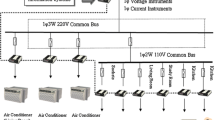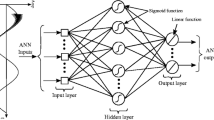Abstract
A recent research interest in demand-side management technology of smart grids is to know what appliances are operating in a home, by giving only the power signals on the main feeder at the entrance of the home. Obtaining knowledge about power signals is possible by replacing old electro-mechanical electricity meters with automatic sensing. This paper presents an intelligent non-intrusive appliance load monitoring (NIALM) design for disaggregating appliances in a power system. A new loads disaggregation methodology is presented based on the self-recurrent radial basis function neural network (SRRBFNN) model that uses an adaptive springy particle swarm optimization (ASPSO) algorithm to optimize the parameters of the SRRBFNN model. In the proposed method, the SRRBFNN identifies appliance loads, determining if they are turned ON or OFF, based on the analysis of load signatures. A feature vector is built via an optimized MinMax Steady-State (MMSS) algorithm and a step-changes identifying unit. The step-changes identifying unit is an event detector capable of detecting the step-changes of input signals whenever an appliance is turned ON or OFF. Compared with the classical PSO (CPSO), the ASPSO shows a superior performance since it utilizes an adaptive procedure through two additional units. The two units follow an updating and a screening mechanism, intending to improve the CPSO performance after trapping on a local optimum. The experimental results indicate that the proposed methodology for solving the NIALM based on ASPSO and SRRBFNN significantly improves the loads’ classification accuracy.






Similar content being viewed by others
References
Angelis, G.-F., Timplalexis, C., Krinidis, S., Ioannidis, D., & Tzovaras, D. (2022). NILM applications: Literature review of learning approaches, recent developments and challenges. Energy and Buildings, 111951.
Araújo Kuhn Pereira, A., Menezes, R. J. A., Jadidi, A., De Jong, P., & de Castro Lima, A. C. (2020). Development of an electronic device with wireless interface for measuring and monitoring residential electrical loads using the non-invasive method. Energy Efficiency,13(7), 1281–1298.
Azaza, M., & Wallin, F. (2017). Evaluation of classification methodologies and features selection from smart meter data. Energy Procedia, 142, 2250–2256.
Basu, K. (2014). Classifcation techniques for non-intrusive load monitoring and prediction of residential loads. PhD thesis.
Bonfigli, R., Felicetti, A., Princip, E., Fagiani, M., Squartini, S., & Piazza, F. (2018). Denoising autoencoders for non-intrusive load monitoring: Improvements and comparative evaluation. Energy and Buildings, 158, 1461–1474.
Bonfigli, R., Principi, E., Fagiani, M., Severinic, M., Squartini, S., & Piazza, F. (2017). Non-intrusive load monitoring by using active and reactive power in additive factorial hidden Markov models. Applied Energy, 208, 1590–1607.
Bouhouras, A. S., Gkaidatzis, P. A., Panagiotou, E., Poulakis, N., & Christoforidis, G. C. (2019). A NILM algorithm with enhanced disaggregation scheme under harmonic current vectors. Energy and Buildings, 183, 392–407.
Cipriano, X., Vellido, A., Cipriano, J., Martí-Herrero, J., & Danov, S. (2017). Influencing factors in energy use of housing blocks: A new methodology, based on clustering and energy simulations, for decision making in energy refurbishment projects. Energy Efficiency, 10, 359–382.
Dash, S., & Sahoo, N. (2022). Electric energy disaggregation via non-intrusive load monitoring: A state-of-the-art systematic review. Electric Power Systems Research,213, 108673.
Deng, X., Liu, Q., Deng, Y., & Mahadevan, S. (2016). An improved method to construct basic probability assignment based on the confusion matrix for classification problem. Information Sciences,340(C), 250–261.
Elsayed, K., & Lacor, C. (2014). Robust parameter design optimization using kriging, RBF and RBFNN with gradient-based and evolutionary optimization techniques. Applied Mathematics and Computation, 236, 325–344.
Figueiredo, M., Almeida, A. D., & Ribeiro, B. (2012). Home electrical signal disaggregation for non-intrusive load monitoring (NILM) systems. Neurocomputing, 96, 66–73.
Fodor, I. K., & Kamath, C. (2003). Denoising through wavelet shrinkage: An empirical study. Journal of Electronic Imaging, 12(1), 151–161.
Gan, M., Chen, C. L. P., Chen, L., & Zhang, C.-Y. (2016). Exploiting the interpretability and forecasting ability of the RBF-AR model for nonlinear time series. International Journal of Systems Science, 47(8), 1868–1876.
Han, H.-G., Guo, Y.-N., & Qiao, J.-F. (2017). Self-organization of a recurrent RBF neural network using an information-oriented algorithm. Neurocomputing, 225, 80–91.
W. Hart, G., Kern, E. C., & Schweppe, F. C (1989). Non-intrusive appliance monitor apparatus. Google Patents. US Patent 4,858,141.
Hart, G. W. (1992). Nonintrusive appliance load monitoring. Proceedings of the IEEE, 80(12), 1870–1891.
Henao, N., Agbossou, K., Kelouwani, S., Dubé, Y., & Fournier, M. (2017). Approach in nonintrusive type I load monitoring using subtractive clustering. IEEE Transactions on Smart Grid, 8(2), 812–821.
Iwayemi, A., & Zhou, C (2014). Leveraging smart meters for residential energy disaggregation. In 2014 IEEE PES General Meeting Conference and Exposition (pp 1–5).
Kanirajan, P., & Kumar, V. S. (2015). Power quality disturbance detection and classification using wavelet and RBFNN. Applied Soft Computing, 35, 470–481.
Kelly, J., & Knottenbelt, W. (2015). Neural NILM: Deep neural networks applied to energy disaggregation. In Proceedings of the 2nd ACM International Conference on Embedded Systems for Energy-Efficient Built Environments (pp. 55–64). ACM.
Kennedy, J., & Eberhart, R. (1995). Particle swarm optimization. In Proceedings of the IEEE International Conference on Neural Networks (pp. 1942–1945).
Lin, S., Zhao, L., Li, F., Liu, Q., Li, D., & Fu, Y. (2016). A nonintrusive load identification method for residential applications based on quadratic programming. Electric Power Systems Research, 133, 241–248.
Li, Y., Yang, Y., Sima, K., Li, B., Sun, T., & Li, X. (2021). Non-intrusive load monitoring based on harmonic characteristics. Procedia Computer Science, 183, 776–782.
Makonin, S., Popowich, F., Bartram, L., Gill, B., & Bajić, I. V. (2013). AMPDS: A public dataset for load disaggregation and eco-feedback research. In 2013 IEEE Electrical Power & Energy Conference (pp. 1–6). IEEE.
Makonin, S., & Popowich, F. (2015). Nonintrusive load monitoring (NILM) performance evaluation: A unified approach for accuracy reporting. Energy Efficiency, 8, 809–814.
Méjean, A., Guivarch, C., Lefèvre, J., & Hamdi-Cherif, M. (2019). The transition in energy demand sectors to limit global warming to 1.5 c. Energy Efficiency, 12, 441-462.
Pereira, L., & Nunes, N. (2020). An empirical exploration of performance metrics for event detection algorithms in non-intrusive load monitoring. Sustainable Cities and Society,62, 102399.
Qu, L., Kong, Y., Li, M., Dong, W., Zhang, F., & Zou, H. (2023). A residual convolutional neural network with multi-block for appliance recognition in non-intrusive load identification. Energy and Buildings,281, 112749.
Ramadan, R., Huang, Q., Bamisile, O., & Zalhaf, A. S. (2022). Intelligent home energy management using internet of things platform based on NILM technique. Sustainable Energy, Grids and Networks,31, 100785.
Sadeghianpourhamimi, N., Ruyssinck, J., Deschrijver, D., Dhaene, T., & Develder, C. (2017). Comprehensive feature selection for appliance classification in NILM. Energy and Buildings, 151, 98–106.
Saraiva, F., Bernardes, W. M. S., & Asada, E. N. (2015). A framework for classification of non-linear loads in smart grids using artificial neural networks and multi-agent systems. Neurocomputing, 170, 328–338.
Shi, Y., & Eberhart, R. C. (1998). A modified particle swarm optimizer. In Proceedings of the IEEE International Conference on Evolutionary Computation, USA (pp. 69–73).
Su, Y. C., Lian, K. L., & Chang, H. H. (2011). Feature selection of non-intrusive load monitoring system using STFT and wavelet transform. In 2011 IEEE 8th International Conference on e-Business Engineering (pp. 293–298). IEEE.
Yang, H., & Liu, J. (2018). An adaptive RBF neural network control method for a class of nonlinear systems. IEEE/CAA Journal of Automatica Sinica, 5(2), 457–462.
Yang, C. C., Soh, C. S., & Yap, V. V. (2017). A non-intrusive appliance load monitoring for efficient energy consumption based on naive bayes classifier. Sustainable Computing: Informatics and Systems, 14, 34–42.
Yang, C. C., Soh, C. S., & Yap, V. V. (2018). A systematic approach in appliance disaggregation using k-nearest neighbours and Naive Bayes classifiers for energy efficiency. Energy Efficiency, 11(1), 239–259.
Yan, L., Sheikholeslami, M., Gong, W., Tian, W., & Li, Z. (2022). Challenges for real-world applications of nonintrusive load monitoring and opportunities for machine learning approaches. The Electricity Journal, 35(5)
Yan, K., Shen, W., Mulumba, T. M., & Afshari, A. (2014). ARX model based fault detection and diagnosis for chillers using support vector machines. Energy and Buildings, 81, 287–2952.
Zhou, Z., Xiang, Y., Xu, H., Wang, Y., & Shi, D. (2021). Unsupervised learning for non-intrusive load monitoring in smart grid based on spiking deep neural network. Journal of Modern Power Systems and Clean Energy, 10(3), 606–616.
Acknowledgements
This work was supported by Project SIICEI “Intelligent System for Identification of Electrical Loads in Industrial Equipment” (reference: SIICEI/2017/33338), co-financed by the “Centro Region Operational Programme” (CENTRO 2020), Portugal 2020 (PT2020), and by the European Union through the European Regional Development Fund (ERDF).

Author information
Authors and Affiliations
Corresponding author
Ethics declarations
Conflict of interest
The authors declare no competing interests.
Additional information
Publisher's Note
Springer Nature remains neutral with regard to jurisdictional claims in published maps and institutional affiliations.
Rights and permissions
Springer Nature or its licensor (e.g. a society or other partner) holds exclusive rights to this article under a publishing agreement with the author(s) or other rightsholder(s); author self-archiving of the accepted manuscript version of this article is solely governed by the terms of such publishing agreement and applicable law.
About this article
Cite this article
Rastegar, S., Araújo, R., Malekzadeh, M. et al. A new NIALM system design based on neural network architecture and adaptive springy particle swarm optimization algorithm. Energy Efficiency 16, 52 (2023). https://doi.org/10.1007/s12053-023-10125-5
Received:
Accepted:
Published:
DOI: https://doi.org/10.1007/s12053-023-10125-5




